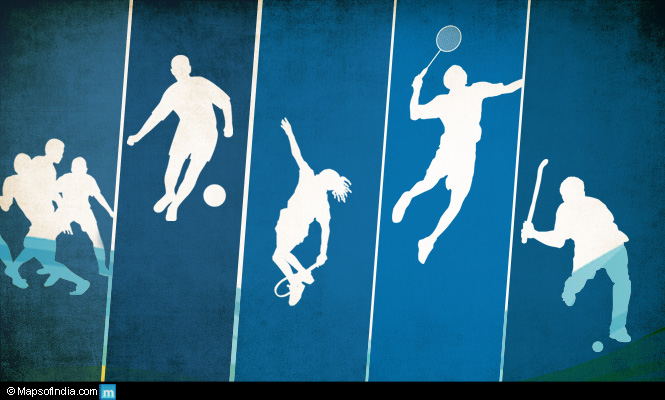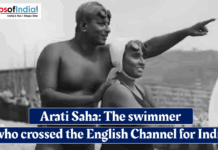 It has been a year of renowned, flourishing and beneficial sports for India as 2014 saw several leagues shaping up. The leagues benefited the players and surely raised the level of sports in India. International names on Indian soil brought recognition to Indian sports as well as the leagues, providing more exposure to Indian players and ultimately increasing the fan following. From the Indian Super league (ISL) to leagues like the Champions Tennis League (CTL), Hockey India League, Indian Badminton League (IBL), International Premier Tennis League (IPTL), all were a big hit as spectators and players got the best of Indian sports.
It has been a year of renowned, flourishing and beneficial sports for India as 2014 saw several leagues shaping up. The leagues benefited the players and surely raised the level of sports in India. International names on Indian soil brought recognition to Indian sports as well as the leagues, providing more exposure to Indian players and ultimately increasing the fan following. From the Indian Super league (ISL) to leagues like the Champions Tennis League (CTL), Hockey India League, Indian Badminton League (IBL), International Premier Tennis League (IPTL), all were a big hit as spectators and players got the best of Indian sports.
The year of leagues proved to be a constructive and encouraging one for the whole country. Of course, the Indian Premier League—the one that started the trend, cannot be forgotten for encouraging business tycoons to invest in other sports and lend a hand towards development of sports in India. Also, the Indian cricket board united with Australia and England to take control of the management.
A year of opportunities for Indian football
The Indian Super League was welcomed in India with much excitement and zeal, as the tournament pulled thousands of spectators to the stands to watch their favourite teams as well as players (both Indian and international). With a FIFA poor ranking, India did not shy away from taking this initiative of giving a chance to their players and develop the sport in India. India has always fared poorly in world football rankings and currently stands at 159 out of 208 countries. But FIFA chief Sepp Blatter has dubbed the world’s second most populous country the sleeping giant of football. The ISL conquered the Indian media, players became well-known and exposure was an added benefit – quite a good beginning! Let’s football was a famous slogan which perched every Indian lip.
The ISL, with eight franchise teams from all over India – Atletico De Kolkata, Mumbai City FC, North East United FC, Kerala Blasters, Delhi Dynamos, Pune City FC, Chennaiyan FC and FC Goa– took place between October and December 2014. The inaugural season of ISL saw Atletico De Kolkata taking away the trophy as they beat Kerala Blasters. Similar to the Indian Premier League, the ISL has a plan to make football a popular sport in India and a known name worldwide. The league did succeed to an extent!
The ISL reached every home bringing football closer to fans with Star Sports (part of the group) broadcasting matches. To make football more acceptable, the ISL succeeded in live telecast of matches on a number of channels that included Star India Sports, movie and also regional channels – eight channels in total. International coverage by Fox Sports in Australia because of stars like Alessandro Del Piero (who is featured in the ISL) was an added bonus. Eurosport 2 also telecast the matches in Europe and Star TV UK in the UK.
Sponsors reached the league rapidly, Hero MotoCorp signing a three-year agreement with the ISL. Hence the league was named Hero Indian Super League. The first edition of the eight-team tournament with celebrity owners and a sprinkling of high-profile players proved quite a hit in an otherwise cricket-crazy country. The Indian Super League proved to be successful so much so that the AIFF plans to host a similar football league for the women category as well in 2015.
International stars uplifted Indian tennis
Similar to the ISL, Indian tennis had a reason to celebrate – The Champions Tennis League (CTL) followed by the International Premier Tennis League (IPTL). The CTL, a 10-day tennis exhibition tournament which was led by Vijay Amritraj was also played on the style of Indian Premier League. The CTL was played across ten Indian cities – Delhi, Mumbai, Hyderabad, Pune, Bengaluru and Chandigarh. It was telecast on Sony Six as well. The CTL was a great show for spectators as well as the players as Cyprus superstar Marcos Baghdatis beat World No 16 Kevin Anderson. Pune Marathas emerged victorious 27-23 over Delhi Dreams sealing the CTL a big hit.
Right after the CTL showcasing legends and stars like Pat Cash, Venus Williams, Jelena Jankovic, followed IPTL – the brainchild of Mahesh Bhupathi – where stars like Roger Federer, Andy Murray, Maria Sharapova, Pete Sampras, Sania Mirza Ana Ivanovic and Novak Djokovic treated fans with their smashes and hits on court. Alongside were Bollywood stars like Aamir Khan and Deepika Padukone hitting the court in style. It was a buffet of stars for the spectators and surely it was the fans that benefited the most!
The IPTL, with a lot of obstacles, finally took off in November this year and that too elegantly with international stars making their presence felt all over India. With four Asian cities: New Delhi (Micromax Indian Aces), Singapore (DBS Sinapore Slammers), Dubai (Musafir.com UAE Royals) and Manila (Manila Mavericks), the IPTL provided great opportunities and exposure to the players. The Indian Aces won the inaugural IPTL season with overall two points ahead of UAE Royals who were the runners-up. The tournament had different categories – Men’s singles, women’s singles, Men’s doubles, Mixed doubles and Past Champions’ Singles.
Rural sport gained recognition
The most victorious yet neglected sport in India too got a makeover this season. Kabaddi – popularly known as the mud-game in India – acknowledged expansion to the image of the sport. With the hard work of players and business tycoons as well as stars investing in kabaddi, the sport received much hype and benefit. With endorsements, packaging, marketing, advertising – all in equal share the sport succeeded in getting a star image in contrast to the rural image that it had.
The two kabaddi leagues – Pro Kabaddi league(PKL) and the World Kabaddi League – enormously changed the lives of players and the representation of the sport. With such hustle and bustle, the crowds too flocked stadiums which in turn encouraged the players to perform well. After winning both the men’s and women’s kabaddi gold medals at the Incheon Games, the players showed their mettle at the Kabaddi Leagues. The PKL, just like the ISL and CTL, is based on the same format as the Indian Premeir League. An eight-city league it consists of eight franchises which have players from all around the world. Eight venues to play 56 league matches makes a total of 60 matches and the players follow the caravan format. Star Sports was the official broadcaster of PKL.
Such an effort surely encouraged the players to put up their best show by being in the best teams. India’s kabaddi captain Rakesh Kumar was bought for Rs 12.80 lakh by Patna franchise and ranked as the priciest among all players while Mostafa Noudehi remained the highest paid overseas player for Rs 6.6 lakh by the Pune Franchise. Abhishek Bachchan’s Jaipur Pink Panthers who won the PKL brought glitz and glamour of Bollywood to the rings and pulled in more crowds.
Talking about World Kabaddi League, it is a professional league played in India, Canada, USA, Pakistan and the United Kingdom. There are eight international teams that play in 14 cities and all over four different countries. Featuring 144 players with around Rs 15 crore as only the players’ salaries, the league was held from August to December this year with United Singhs defeating Khalsa Warriors. The United Singhs along with the trophy of WKL took home Rs 1.8 crore.
The World Kabaddi League looked so interesting to the Bollywood stars that they ended up buying their favourite teams. Akshay Kumar’s Khalsa Warriors (UK), Honey Singh’s Yo Yo Tigers (Canada) and Sonakshi Sinha along with the Hayre Group of UK’s team United Singhs (UK), grabbed newspaper headlines due to celebrity involvement. Honey Singh, a Punjab-born rapper who has many young fans to his kitty had also started Global Fighting Championship (GFC) in Dubai. The WKL is guided by Deputy Chief Minister of Punjab Sukhbir Singh Badal and follows the Formula One touring sports format.
Badminton bringing laurels to the country
The Indian shuttlers have been making us proud with the Indian flag on the podium. As Saina Nehwal and Kidambi Srikanth defeated the Chinese, the China Open Super Series in both men’s and women’s category was grabbed by the Indians. The young Indian, Srikanth beat two-time Olympic gold medallist and five-time world champion Lin Dan and made India proud.
With such talent in India, the Indian Badminton League (IBL) was sure to make waves on Indian soil. The IBL is the richest badminton league in the world with a brand value of US $1 million. The League began in 2013 with six franchises with Indian cities – Delhi, Bangalore, Mumbai, Pune Hyderabad and Lucknow. The inaugural season began ceremoniously in Delhi in August last year. Hyderabad hotshots defeated Awadhe Warriors and emerged winners of the inaugural IBL played at Mumbai.
The second season of IBL was to be played from September to October 2014 but the matches have been postponed to January-February 2015. Compared to season 1 of IBL, the second season has 13 players per franchise instead of 11. However, the number of teams is still the same. This season will also be played on the same six venues as the first season.
National sports regains image
India’s national sport has been recently showcasing their best performances on field regaining the lost glory of the sport. The Sardar Singh-led Indian team has improved tremendously. 2014 has been termed as a re-birth of Indian hockey as the men’s team bagged gold in the Asian Games, qualifying for the Rio Olympics. They also won silver in the Commonwealth Games. The hockey league in India helped the team gain exposure along with inspiration of captaincy from Sardar Singh.
The Hockey India League (HIL) saw its inaugural season last year. The first match was played between Delhi Waveriders and Punjab Warriors at New Delhi in which the Delhi team won 2-1. However, Ranchi Rhinos took away the title from Delhi Waveriders defeating them 2-1 in the final becoming champions of the inaugural season of HIL. The HIL witnesses 34 matches that were played in 28 days.
The second season of HIL was played this year in January in which a new team was added eventually making it a six-team contest. Delhi Waveriders were the winners of the second season of HIL defeating Punjab Warriors 3-1 whereas Ranchi Rhinos finished third.
The third season of HIL will take place from January 22 to February 22 in 2015. With great improvement in players and the anticipation of teams, the plan is to increase the number to eight teams by 2016 and eventually 10 by 2018.
Leagues benefit Indian sports
As the number of leagues kept increasing in India, the sports level too rose, providing more publicity and opportunities to players. The leagues have surely brought a change towards the outlook of Indian sports. Along with discovery of fresh and young talents, the leagues have motivated the players to do better and better. Finally, the hard work of our sportsmen is raking in monetary wealth, which they truly deserve. With growing leagues, each year will bring more benefits and recognition to Indian sports. With support from fans, business tycoons, sports federations, coaches and players, the dream of making Indian sports global is finally shaping up.
These sports leagues have provided sports like kabaddi, football, tennis, badminton and hockey a push and it might help in transforming Indian sports but the organizers, investors, management need to maintain it that way and think of new and innovative ways to make it more beneficial for the best results. Money, management, exposure, investment – all need to move a step ahead every year to make the journey fruitful. With a positive approach everything is possible!
With the success of several leagues this year, the question raised by many is – Will these leagues inspire young blood in our country to take up these sports and make our country reach the top? Yes, why not! We must not forget Japan’s J league which is the best example of transformation on a global stage. Japan reached every World Cup thereafter which provided better opportunities to their players and also helped them bag better contracts and teams all over the world.
Related Information:
Season 2 of Pro Kabaddi League 2015
Lessons from the Kabaddi League event held in India
India won the Kabaddi World Cup 2014 played against Pakistan
Marketing Turns Sports into a Big Business in India




